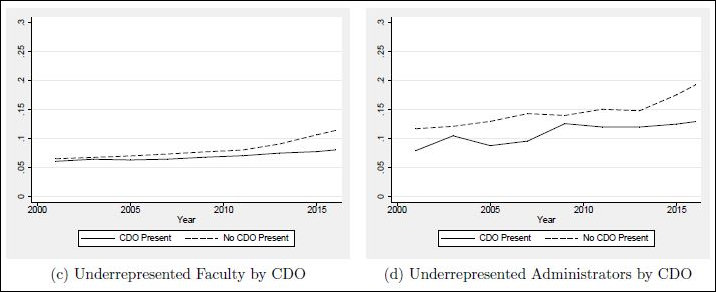By 2016 about 65% of all institutions of higher education had created an executive-level position to promote ethnic and racial diversity on campus. Baylor University professor Steven W. Bradley and three colleagues at other institutions wondered what effect such offices had on the hiring of minority professors. After assembling data on graduate degree-granting institutions with 4,000 students or more, they concluded that the presence of chief diversity officers (CDOs) made no difference at all.
“We are unable to find significant statistical evidence that the preexisting growth in diversity for underrepresented racial/ethnic minority groups is affected by the hiring of an executive level diversity officer for new tenure and non-tenure track hires, faculty hired with tenure, or for university administrator hires,” they conclude in a newly published paper, “The Impact of Chief Diversity Officers on Diverse Faculty Hiring.”
Indeed, as can be seen in the graphs above (though not emphasized by the authors), institutions with CDOs have consistently employed fewer minority faculty and staff, and the gap has gotten slightly wider since 2000.
The paper did not study the impact of CDOs on the recruitment of minority students and graduate students, nor the effect on creating a more hospitable environment for minorities. But in light of the findings, those would seem to be appropriate topics for follow-up study.
Bradley and his fellow researchers attributed at least some of the inability to budge the numbers for minority faculty to the small pipeline of minority Ph.D.-level candidates and to the fact that a large percentage of minority Ph.D.s take jobs outside of academe. Creating a diversity bureaucracy cannot change those intractable realities.
Bacon’s bottom line: I would like to know not only whether a given university has a CDO but how big the CDO staff is and how much money the university spends on CDO offices. To what extent have diversity expenditures driven up the cost of providing a college education? What impact has the growth of diversity bureaucracies had on tuition levels? And, by extension, what impact has funding the growth of diversity bureaucracies added to the cost attendance for minorities — especially poor minorities? Is it possible that CDOs are actually counter-productive to the interest of minority students? Heresy, I know, but it’s a question worth asking.
A fallback defense of CDOs is that at the very least CDOs they help create a more hospitable environment for minorities. But I’d like to see proof for that. One could argue that the continual harping on the theme of minorities as victims of insensitivity and discrimination has the opposite effect intended — minorities, especially African-Americans, wind up feeling more alienated, not more welcome, and they are more likely to self-segregate in self-defense. Which institution do African-American kids says is more “inclusive” — a place like Liberty University, a campus lacking a conventional CDO but where the student body is 11% black, or a place like University of Virginia, which makes a fetish of diversity and inclusion and where 9% of undergraduates are black?
I doubt many university boards are interested in the answers. Hiring chief diversity officers is more about virtue signaling than getting results.
(Hat tip: John Butcher)



